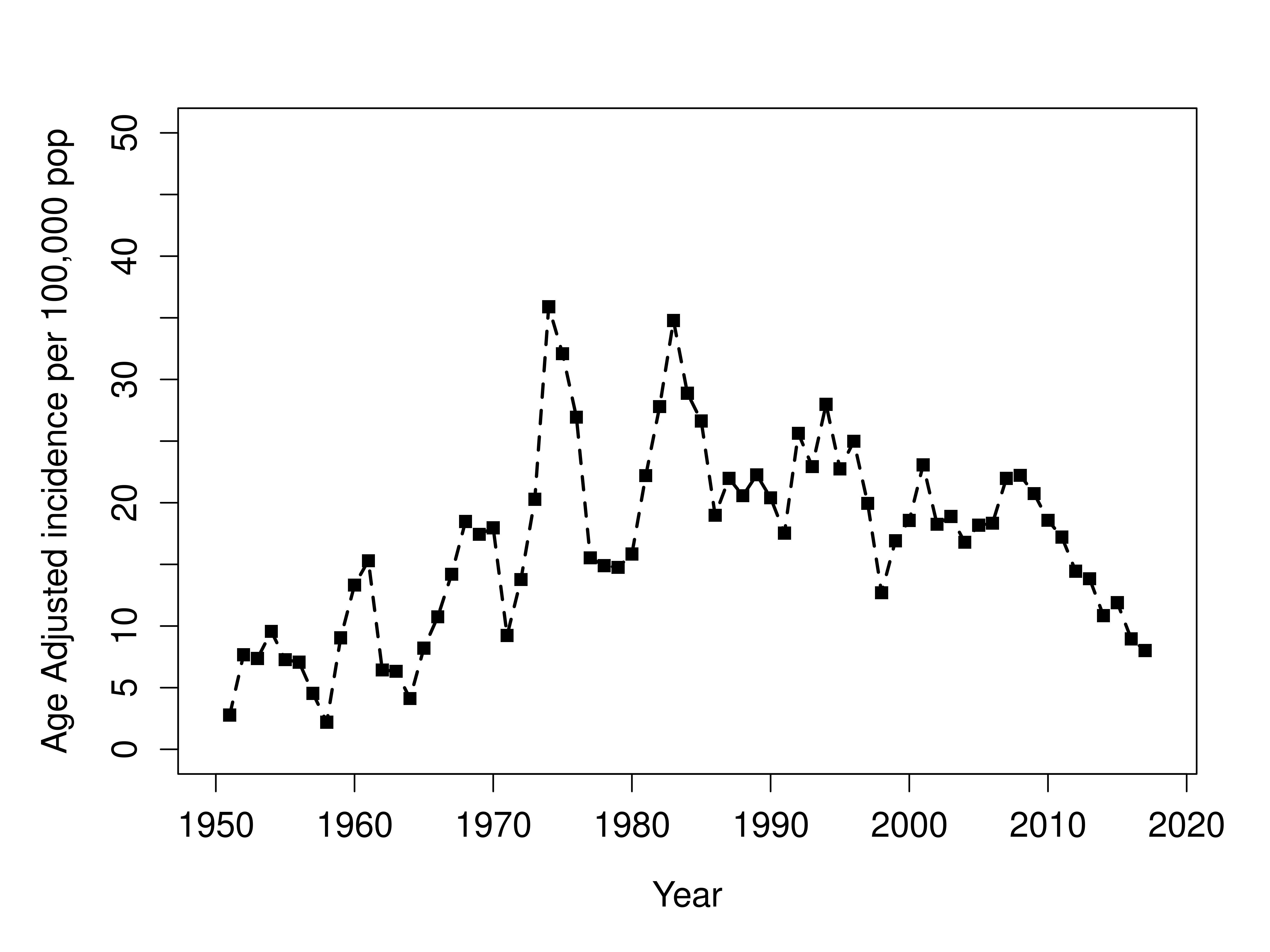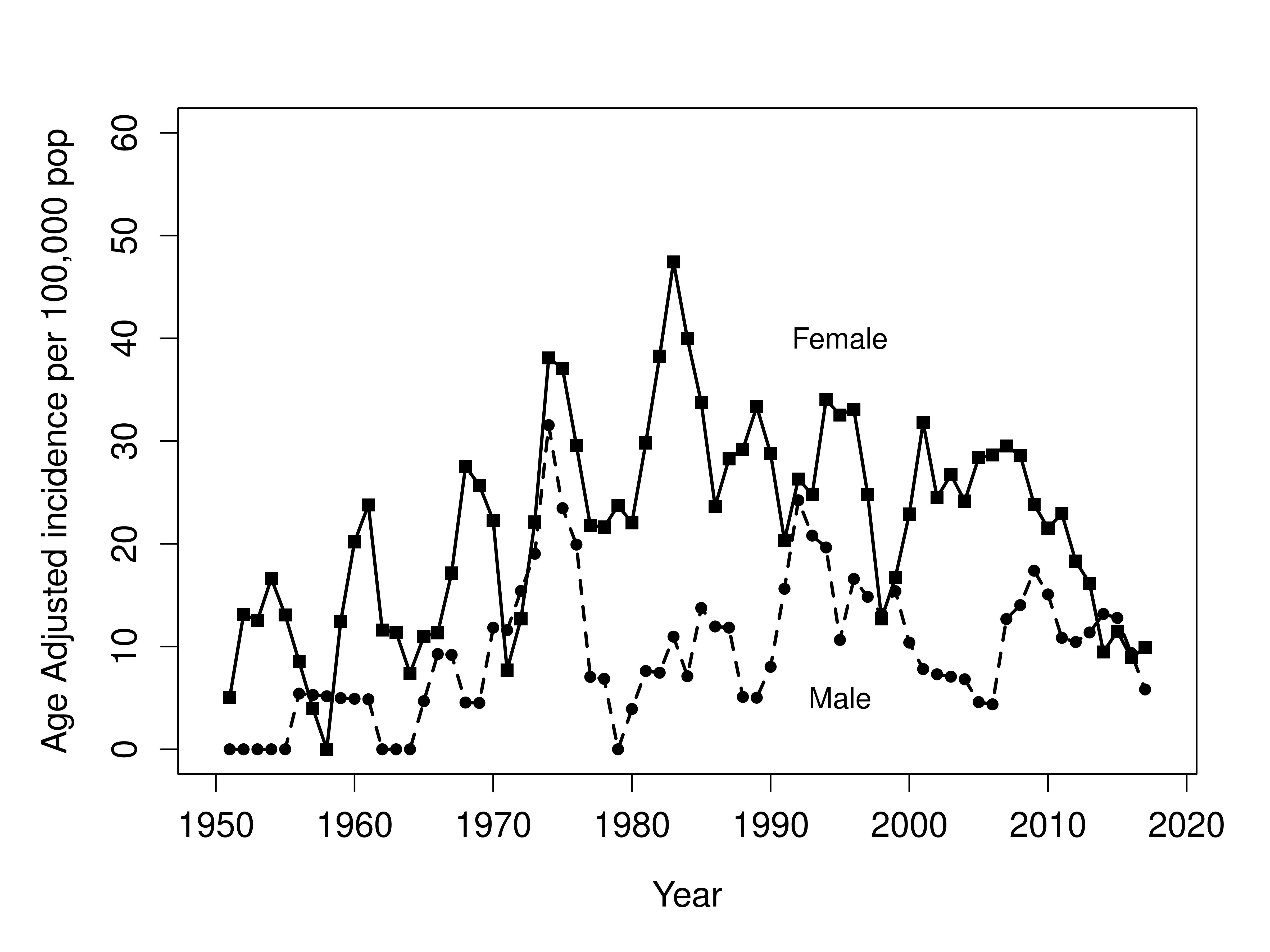Session Information
Date: Friday, November 6, 2020
Title: Vasculitis – Non-ANCA-Associated & Related Disorders II: GCA Clinical & Epidemiology (0514–0518)
Session Type: Abstract Session
Session Time: 4:00PM-4:50PM
Background/Purpose: Diagnostic methods for giant cell arteritis (GCA) have evolved over recent decades, and large vessel imaging plays an increasing role in disease detection. The purpose of this study is to examine the incidence of GCA in recent decades, and to analyze trends in the frequency of GCA subsets according to diagnostic modalities.
Methods: A pre-existing population-based cohort of patients diagnosed with GCA between 1950 and 2009 was extended with incident cases from 2010 to 2018. The diagnosis of GCA was confirmed by review of medical records of patients with ICD9/10 codes for GCA between 1/1/2010 and 12/31/2018. Incident cases that met either one of the following sets of inclusion criteria were added to the cohort: one, American College of Rheumatology 1990 GCA classification criteria; or two, patients aged ≥50 years with elevation of erythrocyte sedimentation rate or C-reactive protein and radiographic evidence of large vessel vasculitis attributed to GCA. Incident cases were classified into one of three groups: group 1, temporal artery biopsy (TAB) positive; group 2, TAB negative or not done with positive large-vessel imaging; or group 3, clinical diagnosis of GCA.
Results: The study cohort included 302 patients diagnosed with GCA from 1950 until 2018. Fifty-two incident cases were diagnosed between 2010 and 2018; 34 females (65%) and 18 males (35%). The age and sex adjusted incidence rates (95% CI) per 100,000 between 2010 and 2018 for females, males, and the total population were 13.6 (9.0, 18.1), 9.8 (5.2, 14.3), and 11.6 (8.4, 14.7), respectively. The corresponding incidence rates from 2000-2009 were 28.1 (21.0, 35.2), 10.2 (5.0, 15.5), and 20.5 (15.9, 25.1), respectively. This represents a significant decline in the incidence rates in females (p< 0.001) and the total group (p< 0.001) between the 2000-2009 and 2010-2018 cohorts but no change in males (p=0.92). Of the 52 patients diagnosed between 2010 and 2018, there were 35 (67%) in group 1, 10 (19%) in group 2, and 7 (13%) in group 3. In contrast, of the 250 patients diagnosed between 1950 and 2009 there were 209 (84%) in group 1, 4 (2%) in group 2, and 37 (15%) in group 3. There was a significant difference between the 1950-2009 and 2010-2018 cohorts in the composition of these groups (p< 0.001).
Conclusion: In this population-based cohort of patients with GCA diagnosed over a 69-year period, the incidence of GCA has declined in recent years. The total decline is driven by a decline in females but not in males. The reasons for this are unclear but should be followed over time and investigated in other population-based cohorts. There has also been a shift in the diagnostic modalities for GCA. In recent years, there are fewer TAB positive patients, and more patients diagnosed with large vessel imaging. This is the first population-based incidence cohort demonstrating a trend towards increased use of large vessel imaging for the diagnosis of GCA.
 Trends in the incidence of GCA in Olmsted County (1950-2018)
Trends in the incidence of GCA in Olmsted County (1950-2018)
 Trends in the incidence of GCA in Olmsted County by sex (1950-2018)
Trends in the incidence of GCA in Olmsted County by sex (1950-2018)
To cite this abstract in AMA style:
Garvey T, Crowson C, Koster M, Warrington K. Trends in the Incidence and Use of Diagnostic Modalities for Giant Cell Arteritis over Seven Decades: A Population-based Study [abstract]. Arthritis Rheumatol. 2020; 72 (suppl 10). https://acrabstracts.org/abstract/trends-in-the-incidence-and-use-of-diagnostic-modalities-for-giant-cell-arteritis-over-seven-decades-a-population-based-study/. Accessed .« Back to ACR Convergence 2020
ACR Meeting Abstracts - https://acrabstracts.org/abstract/trends-in-the-incidence-and-use-of-diagnostic-modalities-for-giant-cell-arteritis-over-seven-decades-a-population-based-study/
